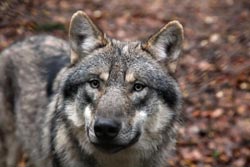No fear of the “bad wolf” – Feeding habits of German wolves investigated

Awakens unfounded fear in many: The wolf<br>© Stefan Seidel
For a long time, wolves had been wiped out in Germany, now they are slowly getting back home. But not everyone is happy at the return of the wild animal. The feeding habits of Canis lupus are the subject of many legends and fables. Wolves that tear sheep apart, eat household pets and even attack people – the return of the predators to German regions awakens fear and generates conflict amongst its inhabitants, hunters and farmers.
“The dietary habits of wolves has been the greatest point of contention with their return to Germany and it induced us to examine in closer detail the feeding habits of the wolves that migrated to Lusatia over ten years ago”, explains Hermann Ansorge, head of the Zoology Department at the Senckenberg Museum of Natural History in Görlitz. “We took a look at what was on the menu for the wolves and how this has changed since the appearance of wolves in East Germany.”
For this purpose the scientists collected over 3000 samples of wolf scat and tested them for undigested evidence of the animals' prey, such as hair, bones, hooves or teeth.
Using this information, supplemented by the findings of the remains of prey, it was possible for the Görlitz zoologists to determine the nutritional intake of the carnivores in detail. Wild ungulates accounted for over 96% of the wolves' prey, according to the investigation. The majority of these were roe deer (55.3%), followed by red deer (20.8%) and wild boar (17.7%). A small proportion of the prey was accounted for by the hare, at almost 3 percent.
“Less than one percent of the prey analysed was of livestock origins” adds Ansorge, continuing: “As long as sheep and other livestock are well protected and there is a sufficient supply of wild animals, the wolves will not risk confrontation with electric fences and guardian dogs.”
The Görlitz zoologists investigated not only what the wolves are eating nowadays, but also how their feeding habits have changed over the years. Wolves are highly adaptable in terms of their dietary intake. For example, it is known from Canada that the wolf packs there feast on salmon in the autumn time.
“We were interested to find out how, why and how quickly the dietary composition of the wolf has changed in Saxony” explains Ansorge. The wolves in Lusatia came to Germany from Poland. There, the packs lived primarily on red deer, in contrast to the German wolves. During the early years of the study, the proportion of red deer eaten was considerably higher, whilst the ratio of roe deer was accordingly lower than in the subsequent five years. “We asked ourselves why the wolves changed their behaviour or whether the initial conditions had changed”, the Görlitz zoologist continues.
In comparison to the Polish forests, those in Lusatia tend to be smaller and crossed by paths and fields. They offer the perfect expansive living space for roe deer and wild boar, whilst red deer tend to retreat to the more spacious wooded areas. Roe deer are therefore a simple and frequent prey from the wolves' perspective.
The shift in eating patterns therefore resulted from the change in the environmental conditions. The wolves quickly adapted – they required less than two generations to become used to the new conditions of the landscape in East Germany.
Since the legal protection of wolves was introduced in 1990, it has taken more than ten years for the wolves in Germany to make themselves at home and bear pups on the Muskau Heath (a military training area). At the present time, nine wolf packs live in Lusatia with around 34 young. “The potential for conflict between man and wolf is very low” Ansorge sums up the results of the study. “There really is nothing standing in the way of the wolf returning.”
Contact
Prof. Dr. Hermann Ansorge
Head of Zoology Department
Section Leader, Mammalogy
Tel. 03581 – 4760-5400
hermann.ansorge@senckenberg.de
Press Office
Senckenberg Gesellschaft für Naturforschung
Judith Jördens
Tel. 069 – 7542 1434
judith.joerdens@senckenberg.de
Publication
Wagner, C., et al., Wolf (Canis lupus) feeding habits during the first eight years of its occurrence in Germany.Mammal. Biol. (2012), doi: 10.1016/j.mambio.2011.12.004
http://www.sciencedirect.com/science/article/pii/S1616504711001625
Researching life forms in their diversity and their eco systems, climate research and geology, the search for past life and finally understanding the complete system of life on earth – this the objective of SENCKENBERG Gesellschaft für Naturforschung. Exhibitions and museums are the viewing windows for natural research, through which Senckenberg imparts current scientific findings to people and provides an insight into past eras as well as the diversity of nature. More information at www.senckenberg.de.
Media Contact
All latest news from the category: Life Sciences and Chemistry
Articles and reports from the Life Sciences and chemistry area deal with applied and basic research into modern biology, chemistry and human medicine.
Valuable information can be found on a range of life sciences fields including bacteriology, biochemistry, bionics, bioinformatics, biophysics, biotechnology, genetics, geobotany, human biology, marine biology, microbiology, molecular biology, cellular biology, zoology, bioinorganic chemistry, microchemistry and environmental chemistry.
Newest articles

Bringing bio-inspired robots to life
Nebraska researcher Eric Markvicka gets NSF CAREER Award to pursue manufacture of novel materials for soft robotics and stretchable electronics. Engineers are increasingly eager to develop robots that mimic the…

Bella moths use poison to attract mates
Scientists are closer to finding out how. Pyrrolizidine alkaloids are as bitter and toxic as they are hard to pronounce. They’re produced by several different types of plants and are…

AI tool creates ‘synthetic’ images of cells
…for enhanced microscopy analysis. Observing individual cells through microscopes can reveal a range of important cell biological phenomena that frequently play a role in human diseases, but the process of…





















